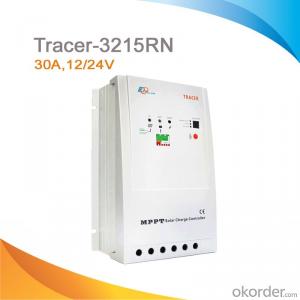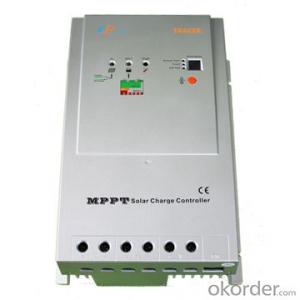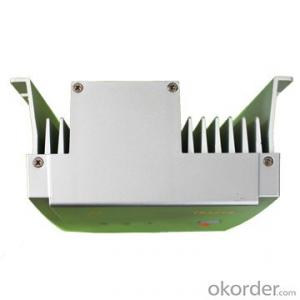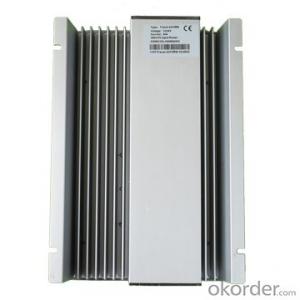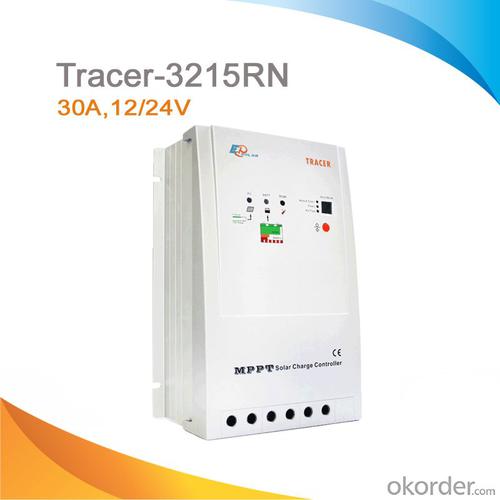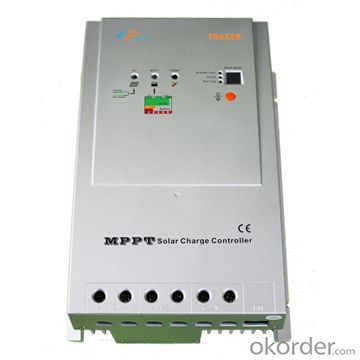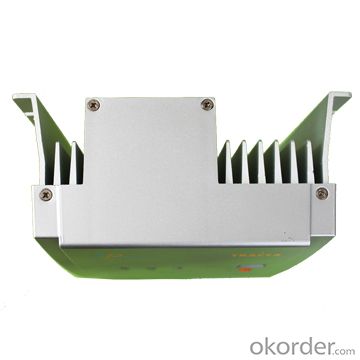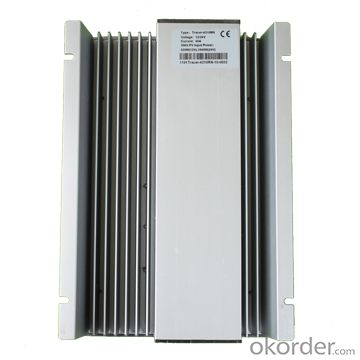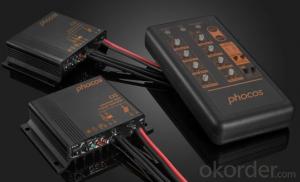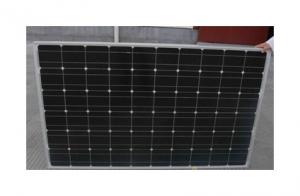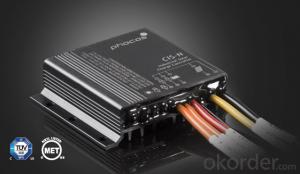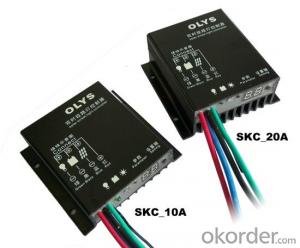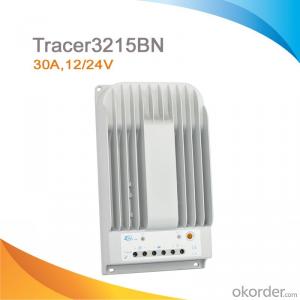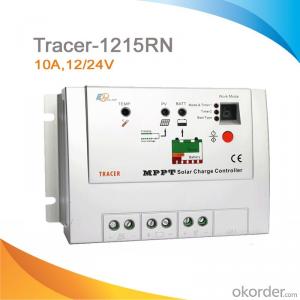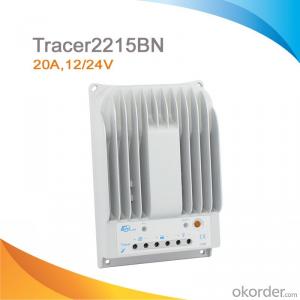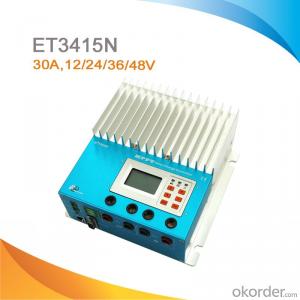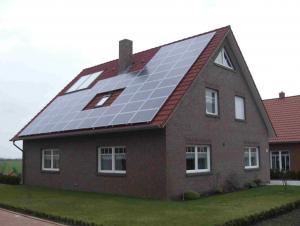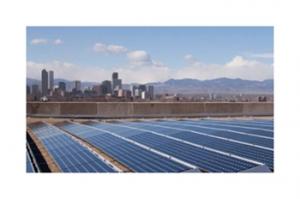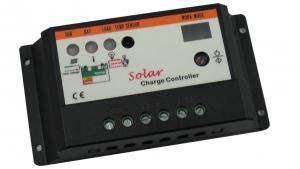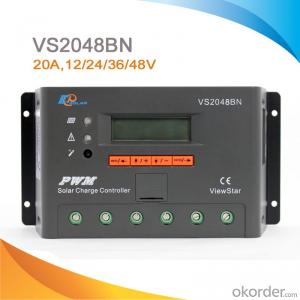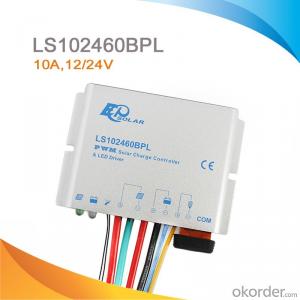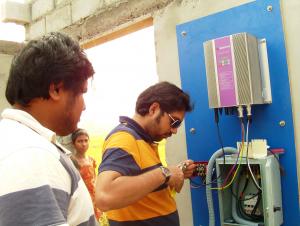Renogy Solar Controllers MPPT Solar Charge Controller for Photovoltaic System 30A, 12/24V Tracer-3215RN
OKorder Service Pledge
OKorder Financial Service
You Might Also Like
Descriptions:
The Charger controller (solar regulator) could store DC generated by solar panels into battery, which could effectively provide living and industrial using electricity in some remote areas and tourism destination areas where have no electric power facilities and electricity network, and have no negative effect on environment.
Specifications
MPPT solar charge controller
Peak Conversion efficiency:97%,
Tracking efficiency:99%
Max. PV input voltage: 100V
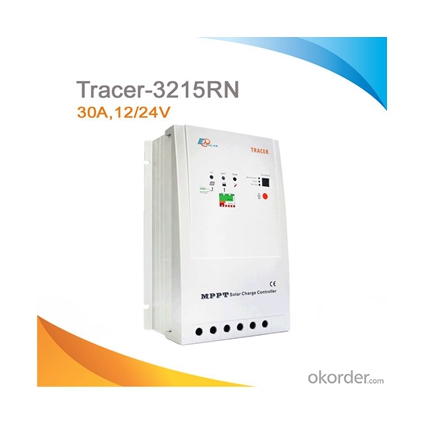
Features:
·MPPT technology
·Peak conversion efficiency of 97%
·High Tracking efficiency of 99%
·Several seconds tracking speed
·4-Stage charge with PWM output
·Nature convection cooling
·Full power output in ambient temperature up to 45 ℃
·Temperature compensation
·Sealed, Gel and Flooded battery option
·Widely used, automatically recognize day/night
·Diversified load control
·RJ45 interface &optional meter
·2 years warranty
·CE certificate
Electronic Protections:
·PV short circuit protection
·PV reverse polarity protection
·PV overvoltage alarm protection
·PV over current protection
·Battery overcharge protection
·Battery over discharge protection
·Battery reverse polarity protection
·Load short circuit protection
·Load overload protection
Specification:
Model | Tracer-3215RN |
Rated system voltage | 12/24V auto work |
Rated battery current | 30A |
Rated load current | 20A |
Max.battery voltage | 32V |
Max.PV open circuit voltage | 150VDC |
Max.PV input power | 12V 390W, 24V 780W |
Self-consumption | <10mA(24V) |
Charge Circuit Voltage Drop | ≤0.26V |
Discharge Circuit Voltage Drop | ≤0.15V |
Communication | TTL232 / 8 pin RJ45 |
Temp.compensation | -5mV/℃/2V |
Working temperature | -35℃~+55℃ |
Storage temperature range | -35℃~+80℃ |
Humidity | 10%-90% NC |
Enclosure | IP30 |
Altitude | ≤3000m |
Dimension | 242mm x 169mm x 91mm |
Mounting holes | 180mm x 160mm |
Mounting hole size | Φ5 |
Terminal | 25mm2 |
Weight | 2kg |
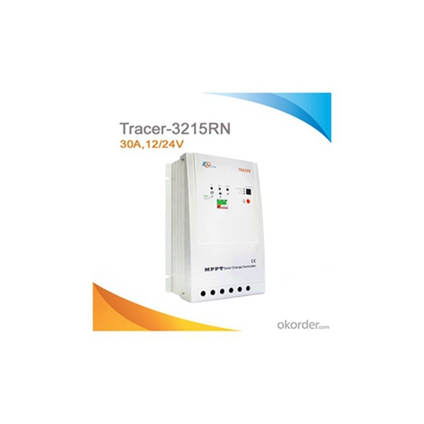
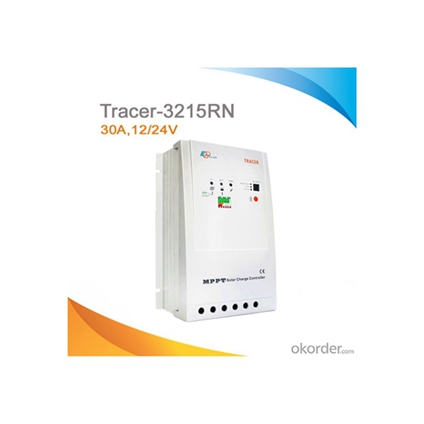
FAQ
1.. What is included in the package?
1*MPPT Solar Charge Controller
1*User Manual
2. What does the battery red indicator LED mean?
Low voltage of battery
- Q: What is the efficiency rating of a solar controller?
- The efficiency rating of a solar controller refers to its ability to convert and control the energy generated by solar panels. It is typically expressed as a percentage, indicating the proportion of solar energy that the controller can effectively utilize and transfer to the connected battery or load. A higher efficiency rating implies that the controller is more efficient at maximizing the use of available solar power, resulting in improved energy conversion and reduced energy losses.
- Q: What is the maximum number of solar panels a solar controller can handle?
- The maximum number of solar panels a solar controller can handle depends on the specific model and its specifications. Different solar controllers have different capacities, typically ranging from a few panels to several dozen panels. It is important to consult the manufacturer's guidelines or product specifications to determine the maximum number of solar panels that a particular solar controller can handle.
- Q: How does a solar controller handle fluctuations in solar panel output?
- The purpose of a solar controller is to regulate and optimize the flow of electricity between solar panels and a battery bank, in order to handle changes in solar panel output. When the solar panels produce excess energy, the solar controller detects this and adjusts the charging current into the batteries accordingly, preventing overcharging and potential damage to the batteries. Conversely, if the solar panel output decreases due to factors like cloud coverage or shading, the solar controller compensates by increasing the charging current. This ensures that the batteries are always being charged efficiently, even during periods of reduced solar panel output. To handle fluctuations in solar panel output, solar controllers incorporate features like Maximum Power Point Tracking (MPPT) or Pulse Width Modulation (PWM) technology. MPPT controllers continuously monitor and track the maximum power point of the solar panels, adjusting the voltage and current to maximize energy harvest. PWM controllers regulate the charging current by rapidly switching the solar panel output on and off, maintaining a stable voltage and preventing overcharging. In summary, a solar controller plays a crucial role as an intermediary between solar panels and a battery bank. Its purpose is to ensure efficient transfer and storage of the energy generated by the panels, regardless of fluctuations in solar panel output.
- Q: What is the maximum number of charging stages supported by a solar controller?
- The maximum number of charging stages supported by a solar controller can vary depending on the specific model and manufacturer. However, it is common for solar controllers to support up to three charging stages, which typically include bulk charging, absorption charging, and float charging.
- Q: How do I install a solar controller in my solar panel system?
- Installing a solar controller in your solar panel system is a relatively straightforward process. Here are the steps to guide you through the installation: 1. Determine the appropriate location: Find a suitable location near your solar panels where you can mount the solar controller. The controller should be protected from direct sunlight, rain, and extreme temperatures. 2. Gather the necessary tools: You will need a screwdriver, wire strippers, electrical tape, and mounting brackets (if not included with the solar controller). 3. Disconnect the solar panels: Before beginning the installation, disconnect the solar panels from the battery and the charge controller, if already installed. 4. Mount the solar controller: Attach the mounting brackets to the solar controller, and then secure the brackets to a suitable surface near the solar panels. Ensure the controller is easily accessible for future maintenance. 5. Connect the battery: Identify the battery terminals on the solar controller and connect the positive (+) and negative (-) leads from the battery. Make sure to follow the proper polarity to avoid damage. 6. Connect the solar panels: Locate the solar panel terminals on the controller and connect the positive (+) and negative (-) leads from the solar panels. Again, ensure the correct polarity to prevent any issues. 7. Secure the connections: Use wire strippers to strip off a small section of insulation from the ends of the wires. Insert the stripped wires into the appropriate terminals on the solar controller and tighten the screws to secure the connections. Ensure all connections are tight and secure. 8. Check the connections: Once all connections are made, double-check that everything is properly connected and tightened. Inspect for any frayed or damaged wires and repair or replace them as necessary. 9. Test the system: Reconnect the solar panels to the charge controller and battery. Turn on the solar panel system and monitor the solar controller to ensure it is functioning correctly. Check for any error or warning messages and troubleshoot accordingly. 10. Perform regular maintenance: After installation, regularly inspect the solar controller for any issues, clean the solar panels, and check the wiring connections. This will help ensure optimal performance and extend the lifespan of your solar panel system. Remember, if you are unsure about any step or lack the necessary electrical knowledge, it's best to consult a professional electrician or solar installer for assistance.
- Q: Can a solar controller handle power surges from the inverter?
- Yes, a solar controller is designed to handle power surges from the inverter. It acts as a protective device by regulating and stabilizing the power flow from the inverter to ensure that the solar system operates efficiently and safely.
- Q: What is the purpose of the battery state of health monitoring feature on a solar controller?
- The battery state of health monitoring feature on a solar controller serves the purpose of ensuring optimal battery performance and longevity. It enables the controller to precisely gauge and monitor the battery's health throughout time, offering valuable insights into its overall condition and capacity. Through this monitoring, the solar controller can undertake suitable measures to preserve and extend the battery's lifespan. These measures include adjusting charging and discharging parameters, preventing overcharging or deep discharge, and notifying the user of any problems that arise. By incorporating this feature, users can maximize the efficiency and dependability of their solar system while avoiding potential battery failures or degradation.
- Q: What is the role of a solar controller in preventing electrical surges in the solar panel system?
- The role of a solar controller in preventing electrical surges in the solar panel system is to regulate and control the flow of electricity between the solar panels and the batteries or the grid. It ensures that the voltage and current levels are kept within safe limits, preventing any sudden spikes or surges that may damage the system components. The solar controller also provides protection against overcharging or over-discharging of batteries, safeguarding the overall system from potential electrical surges.
- Q: How does a solar controller prevent voltage drops in the system?
- A solar controller prevents voltage drops in the system by regulating the flow of electricity from the solar panels to the battery. It ensures that the voltage remains constant and optimal by monitoring and adjusting the charging process. This helps to prevent overcharging or undercharging of the battery, which can lead to voltage drops and affect the overall performance of the system.
- Q: Can a solar controller be used with solar panel ground fault detection systems?
- Yes, a solar controller can be used with solar panel ground fault detection systems. A solar controller is responsible for regulating the voltage and current flow from the solar panels to the battery or grid. It ensures that the solar panels are operating at their maximum efficiency and keeps track of the charging process. On the other hand, a ground fault detection system is designed to detect any ground faults or leakage currents in the solar panel system. It monitors the electrical connections and detects any abnormalities that may pose a safety risk. In most cases, the solar controller and ground fault detection system work independently of each other. The solar controller focuses on optimizing the energy production and storage, while the ground fault detection system focuses on ensuring the safety of the system. However, it is possible to integrate the two systems together. Some advanced solar controllers may have built-in ground fault detection capabilities or can be connected to an external ground fault detection system. This integration allows for more comprehensive monitoring and protection of the solar panel system. In conclusion, while a solar controller and a ground fault detection system serve different purposes, they can be used together to enhance the overall performance and safety of a solar panel system.
Send your message to us
Renogy Solar Controllers MPPT Solar Charge Controller for Photovoltaic System 30A, 12/24V Tracer-3215RN
OKorder Service Pledge
OKorder Financial Service
Similar products
Hot products
Hot Searches
Related keywords
